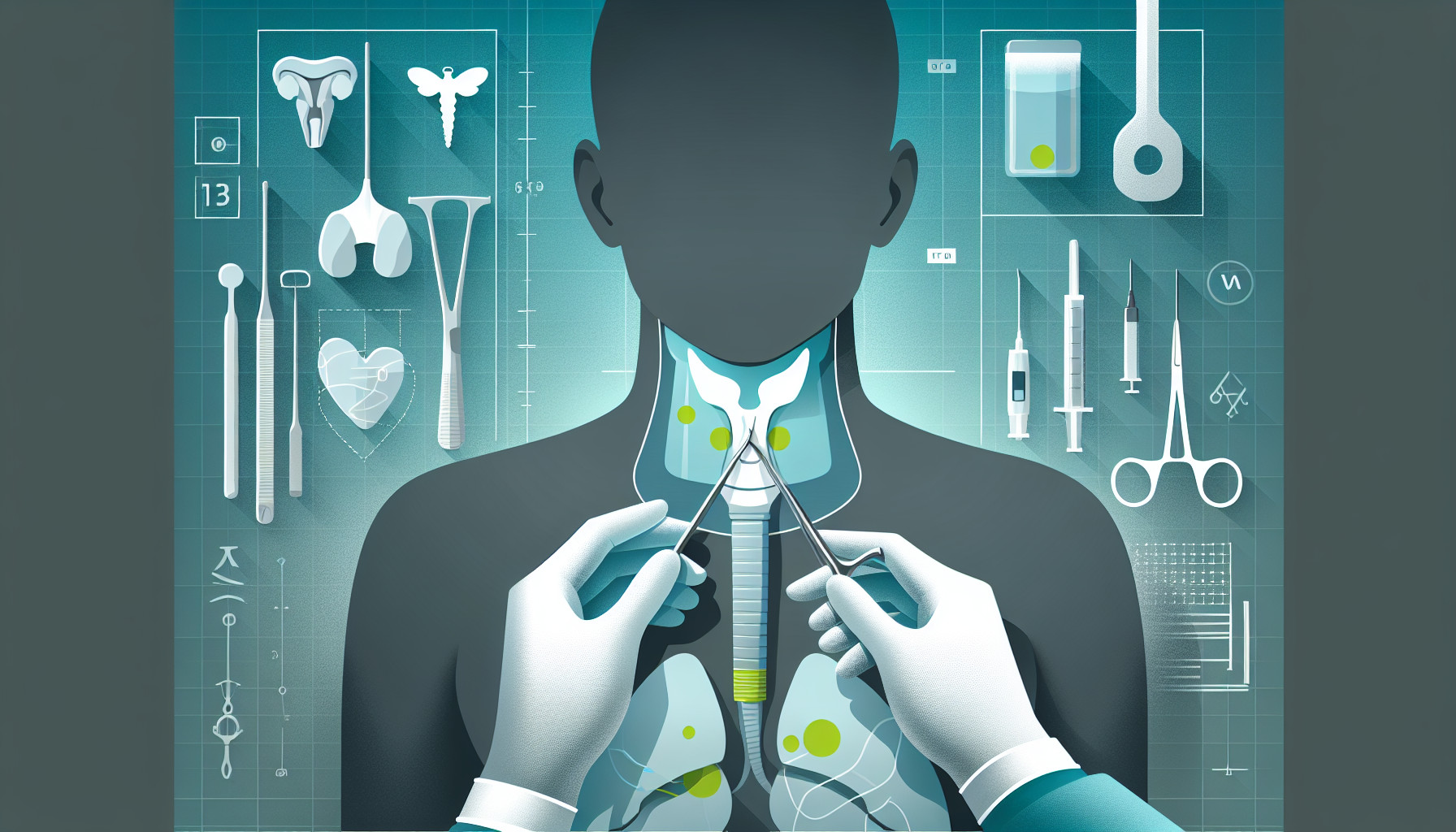Our Summary
This research paper reviewed and compared different types of thyroid surgery to see how effective and safe they are. The surgeries they looked at were the gasless transaxillary approach (GTAA), bilateral axillo-breast approach (BABA), transoral approach (TOA), and traditional transcervical thyroidectomy (CTT).
The researchers scoured medical databases for studies conducted from 2000 to 2023. They focused on how often cancer recurred after surgery and if the surgery completely removed the thyroid. They used blood tests (serum thyroglobulin levels) and the number of lymph nodes removed during the surgery to measure this.
The review included 48 studies involving 16,356 patients. They found that the number of lymph nodes removed in BABA, TOA, and CTT surgeries were about the same. But, for GTAA, this number might be less. The blood tests showed no significant differences among the four types of surgeries. However, GTAA had a lower percentage of patients where the blood tests indicated a complete removal of the thyroid.
Regarding cancer recurrence, the rates were 1.31% for CTT, 0.89% for GTAA, 0.62% for BABA, and 0% for TOA. When they adjusted for how long patients were followed after surgery, the differences in recurrence rates were not significant.
In conclusion, the study showed that GTAA, BABA, and TOA are just as effective as CTT in terms of cancer recurrence. But, in terms of completely removing the thyroid, BABA and TOA are equivalent to CTT, whereas GTAA might be less effective.
FAQs
- What are the three types of remote-access thyroidectomies discussed in the study?
- How were the oncologic outcomes and surgical completeness of the different thyroidectomy methods evaluated?
- Were there any significant differences in recurrence rates among the four types of thyroidectomies studied?
Doctor’s Tip
A helpful tip a doctor might tell a patient about thyroidectomy is to discuss with their surgeon the different approaches available (such as gasless transaxillary, bilateral axillo-breast, transoral, or conventional transcervical) and to consider the oncologic outcomes and surgical completeness of each technique before making a decision. It is important for patients to be informed and involved in the decision-making process to ensure the best possible outcome for their thyroidectomy.
Suitable For
Patients who are typically recommended thyroidectomy include those with:
Thyroid cancer: Patients with thyroid cancer may undergo thyroidectomy as part of their treatment plan to remove the cancerous thyroid tissue.
Large goiters: Patients with large goiters that are causing symptoms such as difficulty breathing or swallowing may require thyroidectomy to alleviate these symptoms.
Hyperthyroidism: Patients with hyperthyroidism that is not controlled with medication or radioactive iodine therapy may undergo thyroidectomy to remove the overactive thyroid tissue.
Recurrent thyroid nodules: Patients with recurrent thyroid nodules that are causing symptoms or are suspicious for malignancy may require thyroidectomy for further evaluation and treatment.
Graves’ disease: Patients with Graves’ disease that is not responsive to other treatments may undergo thyroidectomy as a last resort option.
Thyroid nodules suspicious for cancer: Patients with thyroid nodules that are suspicious for cancer based on imaging studies or biopsy results may undergo thyroidectomy for further evaluation and treatment.
It is important for patients to discuss their individual case with their healthcare provider to determine if thyroidectomy is the appropriate treatment option for their specific condition.
Timeline
Before thyroidectomy:
- Patient undergoes initial consultation with endocrinologist or surgeon to discuss thyroid condition and treatment options.
- Patient may undergo preoperative testing such as blood work, ultrasound, and fine needle aspiration biopsy.
- Patient receives preoperative instructions and may need to adjust medication intake.
- Surgery date is scheduled and patient prepares for the procedure by fasting and following other preoperative guidelines.
After thyroidectomy:
- Patient wakes up in recovery room and is monitored for any immediate complications.
- Patient may experience some pain or discomfort at the incision site.
- Patient is discharged home with instructions on wound care, activity restrictions, and medication management.
- Follow-up appointments are scheduled to monitor thyroid hormone levels and overall recovery.
- Patient may need to take thyroid hormone replacement medication for the rest of their life.
- Long-term follow-up includes monitoring for recurrence of thyroid cancer and overall thyroid function.
What to Ask Your Doctor
Some questions a patient should ask their doctor about thyroidectomy include:
- What are the different types of thyroidectomy procedures available, and which one do you recommend for my specific case?
- What are the potential risks and complications associated with thyroidectomy?
- How long is the recovery period after thyroidectomy, and what can I expect during the recovery process?
- Will I need to take thyroid hormone replacement medication after the surgery?
- How often will I need follow-up appointments or monitoring after the thyroidectomy?
- What is the likelihood of recurrence of thyroid cancer after the surgery?
- How will my vocal cords and parathyroid glands be protected during the surgery?
- Can you provide information on your experience and success rates with performing thyroidectomy procedures?
- Are there any lifestyle changes or dietary restrictions I need to follow after thyroidectomy?
- Are there any alternative treatment options to consider before proceeding with thyroidectomy?
Reference
Authors: Nguyen VC, Lee DW, Song CM, Ji YB, Park JS, Tae K. Journal: Langenbecks Arch Surg. 2024 Apr 10;409(1):117. doi: 10.1007/s00423-024-03316-w. PMID: 38598044
